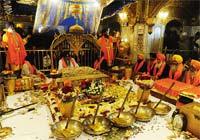A look at Canada’s most ‘visible’ minority

Commentary
By Jagdeesh Mann, Mata Press Service
Sikhs are a contradiction.
Originating from India, they are simultaneously one of Asia’s least urban yet most outward looking communities.
Decades of emigration have taken Sikhs worldwide – to the extent where arguably they have greater political presence in countries like Canada, U.K. and Malaysia than in their own.
In the early 1900s when emigrating was a cultural taboo for most Indians, Sikhs were already serving as policemen in Hong Kong and working in Vancouver Island lumber camps.
Two centuries earlier, again when the need arose, they had made a similar and rapid social transformation as they went from being farmers to soldiers.
That was an era of crippling state repression in India against non-Muslim groups. Sikhs militarized in order to counter the Mughal armies – something akin to rounding up all of the farmers in Saskatchewan and Manitoba today to stave off an American invasion.
At the time, Sikhs had no choice but to make a stand to preserve their own rights.
But they took it a step further and proceeded to sacrifice themselves to preserve the same freedoms for other religious groups in India such as Hindus.
It was out of these conflicts the Khalsa movement emerged and Sikhs became, and remain, today easily identified by their turbans and beards.
Yet as these conflicts subsided they did not draw on their new militarized strength to bully their neighbours or to fortify their lands.
Rather this unpredictable community did just the opposite.
Sikhs pushed on, beyond the natural comforts of their homeland and sought new opportunities from Malaysia to Canada, Kenya to the U.K. — their peripatetic journeys a foreshadowing of today’s global economy.
This unique ability to adapt to new environments, and the changing times ahead is at the heart of the Sikh faith, a humanitarian movement that rejected caste and all artificial boundaries over five hundred years ago through its iconoclastic founder Guru Nanak.
For him all boundaries and all borders were imagined.
Even religious denominations were lines in the sand when he famously stated “there is no Muslim nor Hindu”.
This proclamation equally applies today to Christians, Jews, and Buddhists.
For Nanak, anyone seeking truth starts by walking through the doorway of religion.
In time, that narrow portal opens wider and denominations that claim monopoly over the Divine Name (Satnam) are revealed to be empty semantics.
Eventually there are only human beings who are committed to a path of learning.
And eventually there is only the individual staring into the abyss of his being.
For Nanak, that person is a Sikh – anyone trying to walk the solitary path of looking inward at his relationship with the Divine.
The literal translation of “Sikh” in Punjabi is “learner”.
This rejection of Hindu and all religious rituals, priests, and liturgy was passed down from Guru Nanak through to the 10th Guru, Gobind Singh, whereupon he enshrined all vestige of guidance into the Guru Granth Sahib – a living text composed of poetry from seekers and mystics born appropriately into various Hindu, Muslim and Sikh homes.
Composed of 1,430 sections, the Granth Sahib is more than a book of scripture, it is a living Guru and housed in its own residence (gurudwara).
Its mystical poetry written in Punjabi, Sanskrit, Persian, and Braj has confounded dozens of translators.
For Sikhs, daily meditation on truthful living replaced extravagant rituals and pilgrimages and the living word of the Granth Sahib the interloping of mendacious priests.
A Sikh’s personal relationship with the Granth Sahib is at the heart of his spiritual practice.
And the community’s reverence for and vibrancy of their gurudwaras indicates the overall spiritual health of the faith.
All of the apparent contradictions of Sikhs are ultimately rooted in their ongoing discourse with the Granth Sahib.
The Granth Sahib abounds with mystical passages and paradoxes that expound on the eternal human trials of learning how to love, dispelling anger, and releasing our attachment to worldly desires.
Death is truth and living false, expresses one famous aphorism in the Granth Sahib: the doorway every Sikh must pass through en route to spiritual living is the contemplation of his own mortality.
Another discusses how humans are prone to using logic to deduce the great mystery of existence, only to find their efforts falling short again and again.
The exegesis of any religious text occurs on four levels: literal, moral, allegorical and mystical. It is the mystical interpretation of the Granth Sahib that is the most important to Sikhs.
Mystics of all ages have always attempted to peer deeply between the lines of religious texts in order to gain the most profound insight into life.
By understanding the deepest enigmas in the Granth Sahib, Sikh have pushed the frontiers of religious tolerance and shown how to live amicably in multicultural societies.
The Granth Sahib implores anyone seeking their one’s own spiritual salvation to work for the salvation of all. A Sikh’s life is not to be spent in ashrams or monasteries – as in Buddhism and Christianity – but working in his community, raising a family, and earning an honest living.
To live spiritually is to live dangerously – one among experience all of life’s travails and still retain a sense of equanimity.
A Sikh must strive, said Guru Nanak, to be like a lotus growing in a pond: a perfect contradiction, a heavenly fragrance emerging from the mud.









